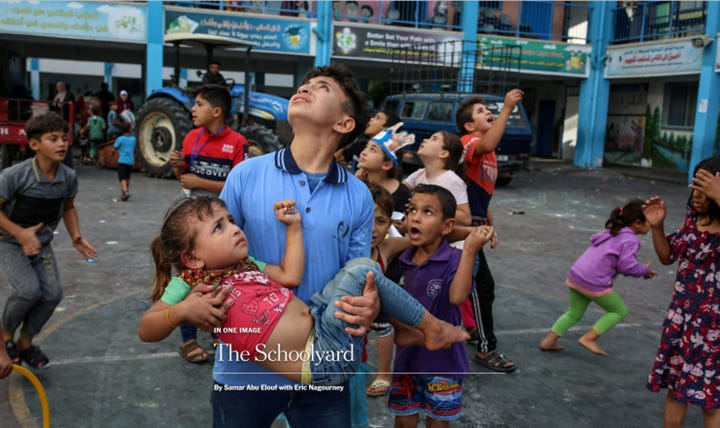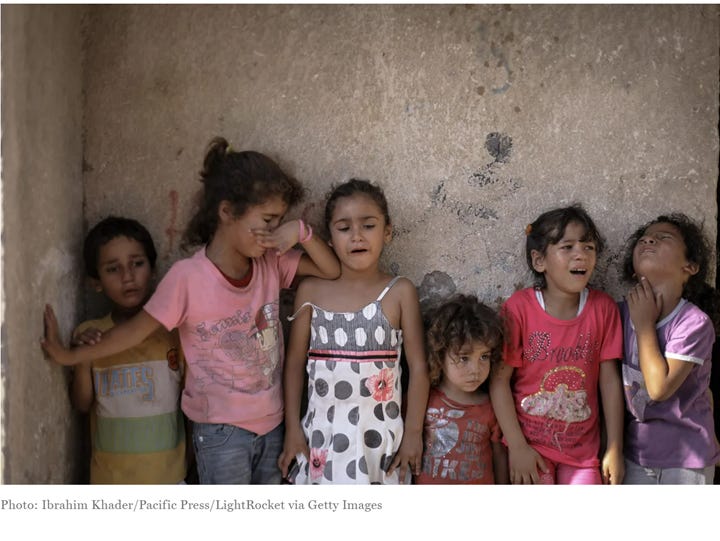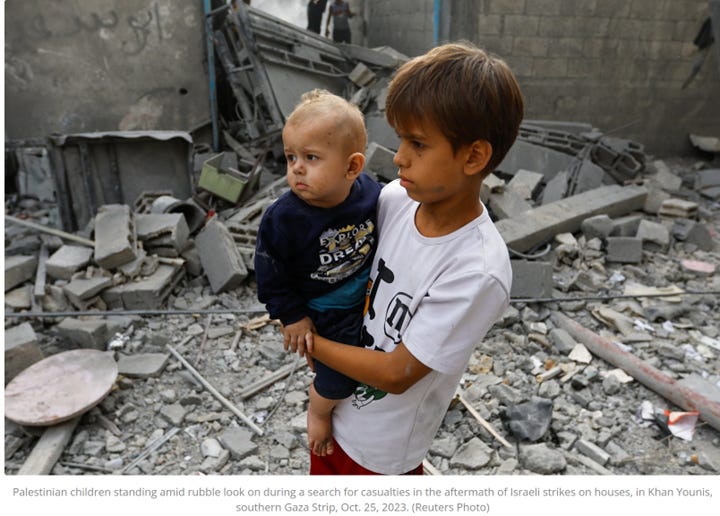More than 2.2 million people live in the Gaza Strip; over half that number are children. And of the 20,000 people who have been killed in the last month alone in Israel’s assault on Gaza, more than two-thirds are women and children.
It goes without saying that Hamas’s kidnapping of several Israeli children is unconscionable.
But today, I’d like to focus our attention on Gaza’s children and how the past and present have converged to affect them.
Before we begin, I’d like to highlight that there’s a link directly below, and again at the bottom of this post, to donate to the Palestine Children’s Relief Fund (PCRF) if you have the means and desire to do so.
A Bit of Background
The Gaza Strip spans a slender enclave on the Mediterranean Sea roughly the size of the United States city known as Philadelphia. Sandwiched between Israel on one side and Egypt on another, the Gaza Strip has long been under occupation—a reality hard enough for adults to survive, let alone children.
It’s impossible to consider the welfare of Gaza’s children outside this context. Let’s take a quick but incomplete pass through the history.
Within five years of the end of World War I in 1918, British forces conquered the Gaza Strip, and made it part of the British Mandate of Palestine. For the next 30 years, two different social systems, one Jewish and one Arab, developed in Palestine. Each society had its own educational, cultural, and welfare institutions.
The Zionist movement set out to acquire land and to encourage Jewish immigrants to the area. Private capital and Zionist institutions purchased large tracts of land, including from Arab landowners. This transformed the demographics of Palestine: the Arab population doubled, while the Jewish population increased tenfold.
In 1948, after the end of World War II, the British ended the Palestine Mandate and brought the “Question of Palestine” to the United Nations. The U.N., in turn, developed a nonbinding resolution to partition Palestine into independent Arab and Jewish states. Because Israel was given the lion’s share of the territory, this decision met with tremendous opposition from the Arab League.
The Arab League declared war on Israel, and the Arab-Israeli War ensued, which again, many people equate to Palestine waging war on Israel. (I’ve said this before, but it bears repeating: Palestine was not part of the Arab League at the time, and therefore, not a party to the war.)
Following Israel’s victory in1949, Egypt administered the newly-formed Gaza Strip, controlling Gaza for nearly two decades.
Then, in 1967, Israel launched the Six-Day War by attacking Egypt, Jordan, and Syria. When the smoke cleared, Israel occupied substantial amounts of Arab territory, plus control of the Gaza Strip and the West Bank.
Between 1969 and 1970, Israel and Egypt fought an undeclared war of attrition, which ended with the help of international diplomacy.
In 1989, in response to the expansion of Israeli settlers and land appropriation in the West Bank, Palestine had its first Intifada, or Uprising.
Under a series of agreements known as the Oslo Accords that took place between 1993 and 1999, Israel transferred security and responsibility for several of the Palestinian territories in the Gaza Strip and West Bank to the Palestinian Authority.
In 2002, Palestine had a second, more violent Intifada, which lasted approximately five years. This uprising resulted in 4,300 deaths; the ratio of Palestinian to Israeli deaths was 3:1.
After this, conditions worsened considerably: Israeli settlement activity in the West Bank grew. Israel placed tight control on the movement of Palestinian goods and people, which stifled economic growth. And in 2006, the last election to take place in Palestine, the militant group Hamas won. They took power by force shortly thereafter in 2007.
Israeli historian Adam Raz has made it his mission to study the relationship between Netanyahu and Hamas. Raz has said that as a candidate for Prime Minister, Netanyahu ran on a promise to eliminate the rule of Hamas in Gaza. When he won, however, he instead pursued a strategy to undermine the Palestinian Authority, Mahmoud Abbas, from establishing a Palestinian State.
Netanyahu accomplished this by allowing millions of dollars in Qatari funds to enter Gaza and enrich the coffers and capabilities of Hamas. This also allowed Netanyahu to “sideline” both the Palestinian authority and the prospect of peace between Israel and Palestine.
There’s more to the history than this; I recommend Rashid Khalidi’s The Hundred Years War and Edward Said’s The Question of Palestine for those interested in learning what’s behind the Palestinian struggle for liberation. You can also watch/read this conversation between Gabor Mate and his daughter, Hannah, which I featured two weeks ago.
Since 2006, there have been no elections in Palestine—a full 17 years. This means that half of Palestine’s population, which are children, did not vote in the last election and have been systematically oppressed by Israel their entire lives.
What This Means for the Children of Gaza
Most of Palestine’s children have been born into what people often refer to as an “open air prison.” But others have stronger words for what is happening: Norman Finkelstein, himself a Holocaust survivor, has called Gaza “the world’s largest concentration camp.”
I frequently hear misinformed people say that Israel “pulled out” of Palestine in 2007. And yet, it’s widely known that this is simply the case. For the next 38 years, Israel enabled the construction of countless Jewish settlement; for those unfamiliar with the term, it means that Israel supported, both socially and militarily, their own residents moving to Palestine. Israeli settlers took over Palestinians’ homes, again displacing them—a form of settler colonialism that continues today.
Israel has granted permits to approximately 17,000 residents of Gaza to enter and work in Israel. However, Israel monitors all food, fuel, and medical supplies that enter Gaza.
Since Hamas seized control of Gaza in 2007, Israel has instituted an ironclad land, air, and sea blockade of Gaza that has had a devastating effect on civilians. Israel restricts the import of goods (including electronic equipment and computers), purportedly because Israel’s government believes that Hamas could use computers to build weapons. But Israel also restricts Palestine’s fuel, food, and water supplies.
International aid groups now face the same problem in Gaza that local businesses and residents have encountered for over 16 years: a blockade that prevents civilians and items such as medicine from moving easily into or out of the area. The 16-year blockade did not apply to the food and fuel that aid groups brought into Gaza.
But since October 7, Israel has instituted a wide blockade of imports to Gaza, stopping all food, fuel, and medical supplies from entering the region.
Gaza’s hospitals regularly suffer from equipment and medicine shortages because of the blockade, and Palestinians in Gaza must apply for permits to leave the enclave to seek treatment either in the West Bank or inside Israel.
As of 2020, over half the residents in Gaza lived below the poverty line. Approximately 77% of Gazan households received aid from the United Nations and other aid groups, typically in the form of food and financial assistance.
A full 65% of people in Gaza are food insecure, meaning that they don’t have reliable access to food. A key reason for this relates to Israel’s airstrikes in 2008 and 2018, which targeted Gaza’s power generation plant and main sewage treatment plant. The attacks resulted in the seeping of sewage waste onto farmland, food crops, and ocean stocks of fish.
According to the June, 2023 issue of Frontiers in Nutrition, even before Israel launched its most recent assault on Palestine, 20 percent of Gaza’s children evidenced stunted growth by two years of age—girls more even than boys.
PBS reported that in October, before the situation on the ground in Gaza was this bleak, the average Palestinian survived on a mere two pieces of bread per day.
The United Nation’s Palestinian refugee agency had been supporting 89 bakeries across Gaza, with the goal of giving 1.7 million people access to bread. But Israel deliberately targeted those bakeries, and only one remains functional.
Thomas White of the Palestinian refugee agency UNRWA, says that “people are beyond looking for bread; they’re looking for water.”
And U.N. deputy Middle East coordinator Lynn Hastings, who is also the humanitarian coordinator for the Palestinian territories, said that only one of three water supplies from Israel is operational. “Many people are relying on brackish or saline groundwater, if at all,” she said.
When my mother was only 7 years old—the age of many Gazan children now—and her sisters were 7 and 10, the Soviet Army imprisoned them in the Gulag close to Siberia. They were allotted one piece of bread per person per day; my mother and her younger sister cried from the stomach pains induced by hunger. I think often of their ordeal as I watch what’s happening to the children of Palestine.
To me, this looks like another iteration of the Gulag.
Trauma and Post-Traumatic Stress in Palestinian Children
We talk often in the psychology, yoga, mindfulness, and embodiment fields about trauma and how to address it. But we speak much more rarely about systemic oppression as a source of trauma, and what bringing a true trauma-informed lens to oppression might look like. Let’s consider for a moment what this colonial history and present carnage might do for the mental health of Palestinian children.
Why, you might wonder, are nearly half the residents of Palestine children? One clear answer is that many don’t get the chance to grow older; they die either in conflicts or due to inadequacies in a healthcare system that is vastly under-resourced.
Two-thirds of Gaza’s population—think over one million children—are either refugees or descendants of refugees from the 1948 Nakba. They already suffer from epigenetic trauma, but also have to contend with frequent conflicts and the blockade of aid, fuel, and food. (For more on epigenetic trauma, see this column from October 5.)
And that’s not all.
Israel systematically imprisons Palestinian children.
According to the annual report issued in 2022 by the Commission for Detainees and Ex-Detainees Affairs, the Palestinian Prisoners Club, Addameer Association for Prisoner Care and Human Rights, and the Wadi Hilweh Center of Jerusalem (all prisoners’ institutions), the number of detentions in 2022 reached a staggering 7,000. Of this number, a full 4,700 are still detained. Of this number, Israel detained 882 children. Israel holds many Palestinian children in administrative detention, meaning that they have not been charged with any crime or received a trial.
Israel’s detention practices violate the rules of international law and the Convention on the Rights of the Child. Between January, 2022 and April, 2023, 73 Palestinian children were martyred in detention.
Israel has a history of employing coercive practices to remove the civilian population.
These can include not just arbitrary arrest and detention, but also murder, torture, rape and sexual assaults, severe injury to civilians, confinement of the civilian population, forcible removal, civilian displacement and deportation, military attacks, threats of attack, land theft, robbery, attacks on hospitals and medical personnel, attacks on schools and refugee areas.
On December 3, the Guardian reported that despite a capacity for AI-guided precision strikes, Israel struck the Jabaliya refugee camp. In the airstrike, a residential square containing more than 300 people was razed to the ground.
Over the past 15 years, children in the Gaza Strip have endured six major moments of crisis: five escalations in violence and the COVID-19 pandemic, plus Israel’s life-limiting land, air, and sea blockade. More than 800,000 Gazan children have never known life without the blockade.
The Emotional Health of Gazan Children
Multiple conflicts, Israel’s blockade on aid and restrictions of movement, and harsh living conditions have caused compounded forms of traumatic stress for Palestinian children.
Five years ago, in 2018, Save the Children conducted a study. They found that 55 percent of children reported emotional distress. Just three years later, in 2021, that number had jumped to 80 percent. In 2022, they reported that 4 out of 5 children live with constant depression, grief, and fear.
Long before the current violence, the Euro-Med Human Rights Monitor compiled a report. Their findings were staggering: A full 91 percent of Gazan children suffered from conflict-related trauma.
More than half of Gaza’s children have contemplated taking their own lives.
Three out of five have resorted to self-injury.
In the words of Craig Mokhiber, who resigned from the U.N. last month in protest over the Israel-Palestine conflict,
"Someday, we will all have to explain. Each of us, if we do not act, will carry with us the indelible stain of #genocide for the rest of our lives. Israel with the complicity of the US, the UK & many in Europe are exterminating the people of #Gaza. No one can claim ignorance."
Imagine this happening to your own children. Your beloved nieces and nephews. The children in your neighborhood, your city, your state. Your country.
And yet, many people are offended by the notion of a ceasefire. Willing to overlook the deaths of "someone else's" children.
Of the many questions we’re all asking in this cultural moment, perhaps the most important one is how we care not just for our own children, but all of humanity’s children.
Sources:
Note: Because there’s a lot of misinformation, disinformation, and propaganda out there, I’ve carefully and thoroughly resourced this article.
For the next 30 years, two different social systems: British Mandate for Palestine | International Encyclopedia of the First World War (WW1). (n.d.). Retrieved December 5, 2023, from https://encyclopedia.1914-1918-online.net/article/british_mandate_for_palestine
For the next 38 years, Israel enabled the construction of countless Jewish settlements: Gaza Strip explained: Who controls it and what to know. (2023, October 9). NBC News. https://www.nbcnews.com/news/gaza-strip-controls-s-know-rcna119405
In 2002, Palestine had a second and much more violent Intifada: Intifada | History, Meaning, Cause, & Significance | Britannica. (2023, November 21). https://www.britannica.com/topic/intifada
When he won, however, he pursued instead a strategy to undermine Mahmoud Abbas: Schneider, T. (n.d.). For years, Netanyahu propped up Hamas. Now it’s blown up in our faces. Retrieved December 4, 2023, from https://www.timesofisrael.com/for-years-netanyahu-propped-up-hamas-now-its-blown-up-in-our-faces/ See also: Hendrix, S. (2023, November 27). Netanyahu and Hamas depended on each other. Both may be on the way out. Washington Post. https://www.washingtonpost.com/world/2023/11/26/netanyahu-hamas-israel-gaza/
Since 2007, over the objections of the United Nations and numerous other human rights groups, Israel has maintained a land, air, and sea blockade on Gaza. Israel maintains that this blockade is necessary to protect Israeli citizens from Hamas. But the blockade has wrought a devastating impact on Palestinian civilians, who cannot enter or exit as will. (Egypt, it should be said, also overseas a checkpoint that limits people coming and going.)
Since 2007, over the objections of the United Nations and numerous: Gaza Strip explained: Who controls it and what to know. (2023, October 9). NBC News. https://www.nbcnews.com/news/gaza-strip-controls-s-know-rcna119405
However, Israel monitors all food, fuel, and medical supplies that enter: Israel’s blockade of Gaza means that a region the size of Philadelphia faces a real risk of starvation, says Peace Studies scholar. (n.d.). Fortune. Retrieved December 4, 2023, from https://fortune.com/2023/10/13/israel-blockade-gaza-hamas-war-starvation-food-insecurity/
Norman Finkelstein, himself a Holocaust survivor, has called Gaza: Scahill, J. (2018, May 20). Blacklisted Academic Norman Finkelstein on Gaza, “the World’s Largest Concentration Camp.” The Intercept. https://theintercept.com/2018/05/20/norman-finkelstein-gaza-iran-israel-jerusalem-embassy/
International aid groups now face the same problem in Gaza that local businesses and residents: Gaza Strip. (2023). In The World Factbook. Central Intelligence Agency. https://www.cia.gov/the-world-factbook/countries/gaza-strip/
Since Hamas seized control of Gaza in 2007: Abdulrahim, R. (2023, October 7). Gaza Has Suffered Under 16-Year Blockade. The New York Times. https://www.nytimes.com/2023/10/07/world/middleeast/gaza-blockade-israel.html
A full 65% of people in Gaza do not have food security: Israel’s blockade of Gaza means that a region the size of Philadelphia faces a real risk of starvation, says Peace Studies scholar. (n.d.). Fortune. Retrieved December 4, 2023, from https://fortune.com/2023/10/13/israel-blockade-gaza-hamas-war-starvation-food-insecurity/. See also: https://www.wfp.org/news/gaza-faces-widespread-hunger-food-systems-collapse-warns-wfp. See also: https://www.theguardian.com/world/2023/nov/17/gaza-un-starvation-disease. See also: https://www.theguardian.com/global-development/2023/nov/04/lack-of-clean-drinking-water-for-95-of-people-in-gaza-threatens-health-crisis
According to the annual report issued in 2022 by the Commission for Detainees and Ex-Detainees Affairs: PCBS | Dr. Awad, highlights the Palestinian children’s situation on the Occasion of the Palestinian Child Day, 05/04/2023. (n.d.). Retrieved December 4, 2023, from https://www.pcbs.gov.ps/site/512/default.aspx?lang=en&ItemID=4484
These can include not just arbitrary arrest and detention, but: United Nations Office on Genocide Prevention and the Responsibility to Protect. (n.d.). Retrieved December 5, 2023, from https://www.un.org/en/genocideprevention/ethnic-cleansing.shtml
A Gaza health ministry spokesperson has said that several people were killed by an Israeli airstrike on Jabaliya refugee camp: https://www.theguardian.com/world/live/2023/dec/03/israel-hamas-war-live-israeli-attacks-on-gaza-continue-overnight-macron-warns-israels-plan-to-eliminate-hamas-risks-decade-of-war
Five years ago, in 2018, Save the Children conducted a study: After 15 years of blockade, four out of five children in Gaza say they are living with depression, grief and fear. (2022, June 15). Save the Children International. https://www.savethechildren.net/news/after-15-years-blockade-four-out-five-children-gaza-say-they-are-living-depression-grief-and
And in 2021, long before the current violence, the Euro-Med Human Rights Monitor: Monitor, E.-M. H. R. (n.d.). New Report: 91% of Gaza children suffer from PTSD after the Israeli attack. Euro-Med Human Rights Monitor. Retrieved December 5, 2023, from https://euromedmonitor.org/en/article/4497
More than half of Gaza’s children have contemplated: After 15 years of blockade, four out of five children in Gaza say they are living with depression, grief and fear. (2022, June 15). Save the Children International. https://www.savethechildren.net/news/after-15-years-blockade-four-out-five-children-gaza-say-they-are-living-depression-grief-and
According to the June, 2023 issue of Frontiers in Nutrition: A. Assaf, E., Al Sabbah, H., & Al-Jawadleh, A. (2023). Analysis of the nutritional status in the Palestinian territory: A review study. Frontiers in Nutrition, 10, 1206090. https://doi.org/10.3389/fnut.2023.1206090
PBS reported that in October, before the situation on the ground: Average Palestinian in Gaza is surviving on 2 pieces of bread a day, UN official says. (2023, November 4). PBS NewsHour. https://www.pbs.org/newshour/world/average-palestinian-in-gaza-is-surviving-on-2-pieces-of-bread-a-day-un-official-says See alaiL Breland, A. (n.d.). UN official: Palestinians in Gaza are living on two pieces of bread a day. Mother Jones. Retrieved December 5, 2023, from https://www.motherjones.com/politics/2023/11/un-official-palestinians-in-gaza-are-living-on-two-pieces-of-bread-a-day/ See also: https://www.pbs.org/newshour/world/average-palestinian-in-gaza-is-surviving-on-2-pieces-of-bread-a-day-un-official-says
Thomas White of the Palestinian refugee agency UNRWA, says: https://www.pbs.org/newshour/world/average-palestinian-in-gaza-is-surviving-on-2-pieces-of-bread-a-day-un-official-says
Only one of three water supplies from Isra*l is operational: https://www.pbs.org/newshour/world/average-palestinian-in-gaza-is-surviving-on-2-pieces-of-bread-a-day-un-official-says








Thank you Bo ❤️
Hi Bo. What about the Nakba in 1948? How did this come about?